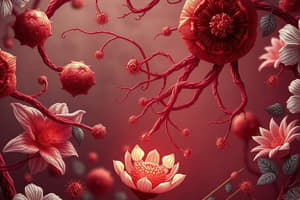Podcast
Questions and Answers
What percentage of blood is composed of plasma?
What percentage of blood is composed of plasma?
- 91%
- 8%
- 45%
- 55% (correct)
Which of the following is NOT a component found in plasma?
Which of the following is NOT a component found in plasma?
- Clotting factors (correct)
- Water
- Nutrients
- Ions
Which type of blood cell is responsible for fighting infections?
Which type of blood cell is responsible for fighting infections?
- Plasma cells
- Erythrocytes
- Thrombocytes
- Leucocytes (correct)
Where are most plasma proteins synthesized?
Where are most plasma proteins synthesized?
Which functional role of blood involves maintaining a stable body temperature?
Which functional role of blood involves maintaining a stable body temperature?
What type of bone marrow is primarily present in newborns?
What type of bone marrow is primarily present in newborns?
What mechanism allows the bone marrow to compensate for blood cell loss during acute anemia?
What mechanism allows the bone marrow to compensate for blood cell loss during acute anemia?
In which organ does extra medullary hemopoiesis primarily occur during chronic hemolytic anemia?
In which organ does extra medullary hemopoiesis primarily occur during chronic hemolytic anemia?
How often must the body replace its blood cells?
How often must the body replace its blood cells?
Which type of blood cells has the longest lifespan?
Which type of blood cells has the longest lifespan?
Flashcards are hidden until you start studying
Study Notes
Hematology
- Study of blood, blood-forming organs, their functions, and diseases
- Blood circulates throughout the body, transporting nutrients, oxygen, and removing waste
- Composed of a liquid component, plasma, and suspended cells and proteins
- Average person has approximately 5 liters of blood, representing 8% of their body weight
Components of Blood
- Blood Cells (45%)
- Red Blood Cells (Erythrocytes)
- White Blood Cells (Leukocytes)
- Platelets (Thrombocytes)
- Plasma (55%)
- 91% Water: Acts as a solvent and suspending medium
- 2% Solutes:
- Ions: Involved in osmosis, membrane potential, and acid-base balance
- Nutrients: Energy source
- Vitamins: Promote enzyme activity
- Gases: Oxygen for aerobic respiration, Carbon Dioxide as waste product of aerobic respiration
- Regulatory Substances: Hormones
- Waste Products: Urea, uric acid, etc.
- 7% Plasma Proteins: Albumin, Globulins, and Fibrinogen
- Plasma proteins primarily synthesized by the liver, except circulating antibodies (immunoglobulins) which are produced by B-lymphocytes
Serum
- Plasma minus clotting factors (fibrinogen, prothrombin, factor V, and antihemophilic factor VIII)
- Formed when blood is allowed to clot and the clot is removed
Functions of Blood
- Transporting oxygen and nutrients to lungs and tissues
- Forming blood clots to prevent excessive blood loss
- Carrying cells and antibodies to fight infections
- Transporting waste products to kidneys and liver for filtration and cleaning
- Regulating body temperature
Hemopoiesis
- The process of blood cell production and development
- Occurs continuously throughout life
- Types:
- Erythrocytes (Erythropoiesis)
- Leucocytes (Leucopoiesis)
- Thrombocytes (Thrombopoiesis)
Bone Marrow
- Primary site of hemopoiesis from 6 months of fetal life onwards
- Contains two types:
- Red Bone Marrow: Responsible for blood cell production
- Yellow Bone Marrow: Composed of fat cells
- At birth, all bone marrow is red, but progresses to yellow in long bones during childhood and adulthood
- In adults, hemopoietic marrow is confined to the central skeleton and proximal ends of the femur and humerus
Extra Medullary Hemopoiesis
- Occurs when normal bone marrow cannot compensate for blood cell loss
- Blood cell production shifts to sites outside the bone marrow, mainly the liver and spleen
- Often seen in chronic hemolytic anemia
- Results in enlarged liver and spleen (hepatosplenomegaly)
Hematopoietic Stem Cells (HSCs)
- All blood cells originate from HSCs
- Rare cells, roughly 1 in every 20 million nucleated cells in bone marrow
- Possess two key abilities:
- Self-renewal: Can produce more HSCs
- Pluripotency: Can differentiate into any blood cell line
Types of Stem Cells
- Pluripotent Stem Cells: Give rise to both myeloid and lymphoid cells
- Myeloid Stem Cells: Generate myeloid cells (blood cells)
- Lymphoid Stem Cells: Give rise to lymphocytes
Development of Blood Cells
- Pluripotent stem cells produce myeloid and lymphoid stem cells
- Myeloid stem cells develop in red bone marrow and produce red blood cells, platelets, monocytes, neutrophils, eosinophils, and basophils
- Lymphoid stem cells begin development in red bone marrow but complete it in lymphatic tissues and produce lymphocytes
Hematopoietic Regulating Factors
- Hormones and other factors regulate hemopoiesis
- Erythropoietin: Produced by kidneys, stimulates red blood cell formation
- Thrombopoietin: Produced by the liver, stimulates platelet formation
- Cytokines:
- Colony-Stimulating Factors (CSFs): Stimulate white blood cell formation
- Interleukins: Stimulate white blood cell formation
Other Factors Supporting Hemopoiesis
- Nutrients: Iron, vitamins (B12, folic acid), and amino acids
- Bone Marrow Environment: Supportive tissue such as macrophages, fatty cells, and fibroblasts
Macrophages
- Play pivotal roles in hemopoiesis:
- Store iron in bone marrow
- Remove aged red blood cells
- Release cytokines to regulate hemopoiesis
Assessment of Hemopoiesis
- Several methods are used to evaluate hemopoiesis:
- Hematocrit (Htc) and Hemoglobin (Hb) levels: Measure red blood cell volume and oxygen-carrying capacity
- Complete Blood Count (CBC): Provides counts for red blood cells, white blood cells, and platelets
- Blood Film: Examines cell morphology
- Reticulocyte Count: Measures young red blood cells in circulation
- Bone Marrow Aspiration: Evaluates the health and function of bone marrow
Blood Film
- A microscopic examination used to visualize the different blood cells
- Can identify abnormalities in cell morphology and numbers
Reticulocyte Stain
- A specialized stain to identify immature red blood cells (reticulocytes) in a blood smear
- Helps assess red blood cell production in the bone marrow
Studying That Suits You
Use AI to generate personalized quizzes and flashcards to suit your learning preferences.




